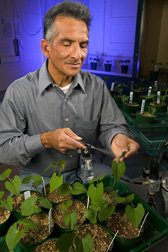This page has been archived and is being provided for reference purposes only. The page is no longer being updated, and therefore, links on the page may be invalid.
|
Read the magazine story to find out more. |
|
|
New Pintos Resist Bean Diseases
By Laura McGinnisJune 12, 2006
Five new pinto bean lines released by the Agricultural Research Service (ARS) can resist significant bean diseases.
The new lines, known as “BelDakMi-RMR” and numbered 19 to 23, are resistant to common bean rust, caused by the rust fungus Uromyces appendiculatus, and to the common mosaic and common mosaic necrosis viruses. These diseases reduce yield and crop quality and increase production costs.
Scientists at the Vegetable Laboratory, part of ARS' Henry A. Wallace Beltsville (Md.) Agricultural Research Center, bred the lines in collaboration with colleagues at North Dakota State and Michigan State universities.
Most commercial bean varieties contain two or fewer disease-resistance genes. The BelDakMi pintos have six resistance genes--more than any other known bean. Each contains four genes for resistance to U. appendiculatus, and two for resistance to bean common mosaic and bean common mosaic necrosis.
According to ARS plant geneticist Marcial Pastor-Corrales, who worked on the project, the pintos are resistant to every known strain of these variable pathogens.
Beans are an economically important crop in this country and a nutritious source of vitamins, proteins, iron, folate, fiber and complex carbohydrates for millions of people around the world.
Read more about this research in the June 2006 issue of Agricultural Research magazine.
ARS is the U.S. Department of Agriculture’s chief scientific research agency.

